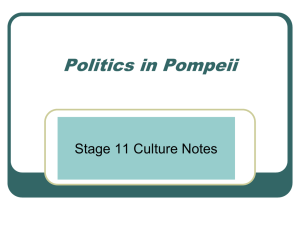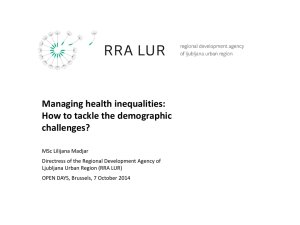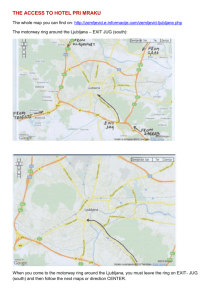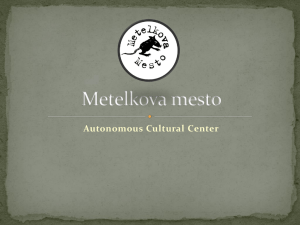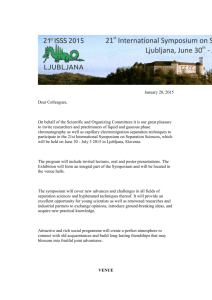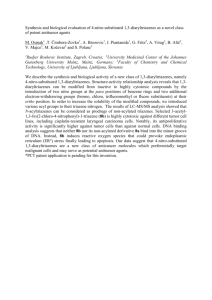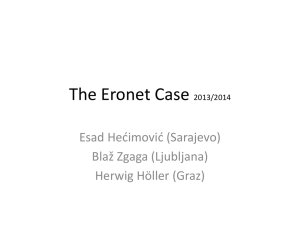Development Vision for the Rog – Centre of
advertisement
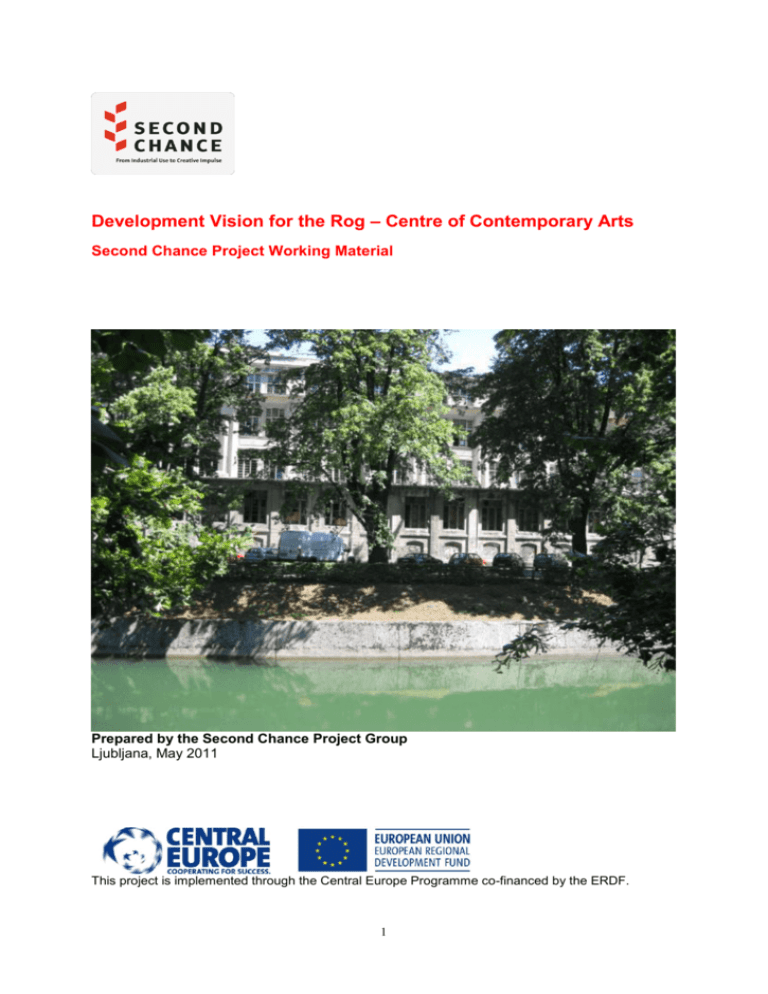
Development Vision for the Rog – Centre of Contemporary Arts Second Chance Project Working Material Prepared by the Second Chance Project Group Ljubljana, May 2011 This project is implemented through the Central Europe Programme co-financed by the ERDF. 1 I. Introduction The Rog factory represents one of the last preserved quality examples of old industrial architecture, and at the same time, a degraded post-industrial area, in the centre of Ljubljana. In 2007, the City of Ljubljana focused intensely on the project of revitalising the whole area of the former Rog factory and renovating the factory into a Centre of Contemporary Arts (CCA) dedicated to architecture, design and visual arts. The Rog CCA project is based on the City of Ljubljana’s Strategy for Cultural Development 2008–2011. The programme outline made in 2007 was followed by a series of analyses, carried out by the City of Ljubljana, of the needs of the renovation. In 2010, the City of Ljubljana joined Second Chance, a European project that, in Ljubljana, focuses on developing the content and management conception of the new Rog Centre. The Development Vision for the Rog – Centre of Contemporary Arts is working material based on: Programme Outline for the Rog – Centre of Contemporary Arts (2007) and the first analyses of the Second Chance project: examples of good practices, the SWOT analysis of the Rog factory revitalisation project,1 the international analysis of public-private partnership (PPP) in the field of culture and the results of meetings with stakeholders. Based on the responses to this vision, we aim to check the justification and feasibility of the content of the future Rog Centre. 1 Because the SWOT analysis lacks quality field data and recommendations for possible future strategies, we adapted the methodology used in preparing the Rog CCA Usage Outline and introduced focus groups. 2 II. The Background Information of the Site and the Renovation project From the end of the 19th century until 1952, the Rog factory manufactured various leather products. From 1952 to the beginning of the 1990s, it was a bicycle factory that (at first) also manufactured typewriters. In the 1990s, the abandoned building was occasionally used for cultural events (art and design festivals). In 2006, the building was occupied by temporary users (artists, Social Centre, Yoga Centre, skateboarding venue, etc.) who still operate in Rog to this day. In 2002, the City of Ljubljana signed a leasing contract for the area of the Rog factory. The renovation and revitalisation of the Rog area are based on the concept of the creative city and represent an architectural and urban-planning solution for the listed building and the immediately surrounding degraded post-industrial area. Neither a gradual renovation nor a mere adaptation of the Rog factory are options due to the poor condition of the building. One important aim of the renovation is the revitalisation of the Eastern part of the city centre, which is anticipated to grow into an important development axis of the city centre and its opening alongside the Ljubljanica River. By thoughtfully connecting culture and private initiative, the City of Ljubljana plans to vitalise this part of the city, giving it a new boost. In 2007, a working group of three experts (an artistic director of a non-profit gallery, a designer and an architect) prepared a programme outline for a Centre of Architecture and Design as well as a renovation plan for the Rog factory area on the basis of the City of Ljubljana guidelines. The programme outline for the new centre at Rog was later complemented and expanded by the City of Ljubljana to also include visual arts. On the basis of the programme outline, a public architectural and urban-planning call was carried out (2008). The selected project for the arrangement of the area includes: the renovation of the listed Rog factory building into the Centre of Contemporary Arts (8,260 m2) and the 3 construction of a new extension for a large exhibition venue (cca. 1,800 m2); an underground car park (578 spaces); a hotel (alongside Trubarjeva Street); apartments (alongside Rozmanova Street); and business premises. The revitalisation project will be implemented using the PPP model. Public part: Rog CCA and the appertaining underground car park (50 spaces). Private part: apartments, a hotel, business premises and the appertaining underground car park (528 spaces). Currently, the revitalisation project is limited to the renovation of the listed Rog factory building, with the construction of the CCA and business premises on the ground floor of the future Rog centre (shops, cafes, etc.) and the construction of an underground car park with the possibility of building a hotel/apartments. Currently, the City of Ljubljana is waiting for the building permit and is preparing a call for obtaining a private partner who would invest in the renovation of the Rog factory building and the construction of the car park. In exchange, the private partner will obtain the ownership rights to the business premises on the ground floor of the Rog Centre (alongside the Petkovškovo embankment) and the larger part of the underground car park, as well as the right of superficies for the future hotel/apartments. III. Renovation Costs Investment costs for the Rog Centre , hotel/apartments and the underground car park: EUR 52,076,203 (investment costs for the Rog Centre – public part: EUR 19,788,957; investment costs for the hotel/apartments, underground car park and commercial premises – private part: EUR 32,287,246). The planned budget does not yet include furnishings and technical equipment.2 IV. The Vision of the City of Ljubljana and the Meaning of the Rog Centre for the Development of Ljubljana With the Rog Centre, Ljubljana will start implementing the creative city concept as its own development model. By mounting ambitious exhibitions enabled by a large, well equiped exhibition hall, 2 The centre’s aim is to support creativity and innovation, which is why the artists need to have access to the latest technology. 4 the Rog Centre will drastically raise the level of interest in visual arts, design and architecture, addressing a broad circle of visitors. By providing production facilities (workshops, laboratories, studios and artist-inresidence studios), Rog will become a new creative centre in Ljubljana. The Rog Centre will be a new production space, whose programme will be oriented towards systematically connecting visual arts, design, architecture and industry. Furthermore, by creating new products, it will substantially contribute to the development of these fields, becoming a prominent factor in Ljubljana’s development. It will enable the development of PPP in the field of creative and cultural industries (CCI) and encourage synergies between culture and business. The Rog Centre will represent a new model of an education and research centre that will connect the cultural and artistic field, science and technology. The Rog Centre will be a high-quality socialising space, which will radically raise the level of the city’s cultural offering with its programme and its integrated architectural and urban-planning concept, thus becoming a venue that will be interesting for a broad circle of inhabitants and visitors. The Rog Centre will became a referential exhibition venue in the region, hosting the best Slovenian and foreign artists, scientists and other experts, thus putting Ljubljana on the map of the most creative cities. With the international orientation of its programme and the artist-in-residence programme, it will place Ljubljana in the network of comparable European centres. 5 V. Programme Outline and Content The new centre is conceived as a production, research, exhibition and socialising space. It will be dedicated to visual arts (in the broadest sense of the term), architecture and design, their interconnection and their strategic connection with the business sector and education, with a strong emphasis on international cooperation. The Rog Centre will realise its goals by making strategic connections with appropriate government initiatives and with the already existing players in these fields, thus ensuring credible programmes that will also be interesting for businesses. Architecturally, the Rog Centre is conceived so that the rooms can be adapted to the purposes and spatial needs of artistic creation. Presentation areas include a large exhibition hall on the ground floor and multipurpose halls on the 1st floor. Connected to the large exhibition hall are: access, reception, a gallery shop, a cloakroom for visitors, lecture rooms, and a media library. The large exhibition hall will be dividable into three smaller rooms. Spaces intended for education are planned within the multipurpose halls on the 1st floor. Production area: on the top two floors of the building; it includes studios, artist-in-residence studios, workshops and laboratories. Socialising area: a café or restaurant is planned to be located at the junction of the production and exhibition areas on the 1st floor. In the architectural solution, it is connected with a terrace. Depository: for keeping exhibits and the equipment for ongoing exhibition activities; it is planned to be located in the basement. Offices are planned for the 1st floor. 6 Picture: Cross-section of the Rog CCA, MX_SI studio, Barcelona 7 Table: Net floor-plan surface of the new complex according to programme and content3 Surface in m² Share Programme and Content Common public-private programme 717.52 2.10% 10,510.46 30.78% 1,824.40 5.34% 690.00 2.02% 2,019.29 5.91% 299.86 0.88% 1,172.87 3.43% 75.00 0.22% - Studios/production areas 2,986.47 8.75% - Car park 1,442,57 4.22% 22,918.76 67.12% 1,087.74 3.19% - Shops 498.29 1.46% - Underground areas of the future hotel 719.20 2.11% 5,380.00 15.76% 15,233.53 44.16% Public programme - Large exhibition hall - Depository - Accompanying programme - Administration - Multipurpose halls - Bar Private programme - Restaurants and bars - Hotel/apartmnents - Car park Total 34,146.74 100.00% VI. Expected Partnerships and Users In order to create and implement the programme for the Rog Centre, programme partnerships with the public sector (universities, public cultural institutions, research institutes, etc.) and the private sector (NGOs, companies, etc.) are expected. The target groups of users are designers, architects, visual artists, scientists, researchers, innovators, the expert public, students, children, schoolchildren, inhabitants of Ljubljana and tourists. Rog will be a frequented, dynamic centre where artists and partners will operate on a projectto-project basis. This means that organisations or artists involved will not have their domicile at Rog. Partners will be sought on the basis of a preconceived programme and the centre’s programme orientation. The definition of programme partnerships is currently still open. Current legislation allows providers of cultural programmes in the public interest to pay only 3 The surfaces are based on the Detailed Project for Obtaining the Building Permit. 8 for the actual material costs of using the infrastructure in public institutions. Special attention will have to be paid to how the Rog Centre (beginning already during its construction) will fit into the existing institutional and social networks and how it will generate new ones. The Rog Centre will be an institution that will complement and/or extend the programmes of existing institutions, organisations, operations and private initiatives. Education and Research Institutions At the Rog Centre, the City of Ljubljana expects the educational programmes, which will count as part of a curriculum, to be conducted in cooperation with private and public educational institutions. The programme at Rog will be able to fill the holes in the field of education and connect the students of various faculties and academies. The City of Ljubljana sees an opportunity in the connection, through projects, of students and foreign and Slovenian experts into working groups, as well as in their cooperation in the development of new products, in research projects, etc. The SWOT analysis detected little involvement of students in extra-curricular activities related to their future professional field and a poor connection between them. The stakeholders active in the field of public higher education have expressed a need for interdisciplinary education and at the same time pointed out the financial limitations in conducting complementary study programmes. Public Institutions The City of Ljubljana expects that the public institutions will be able to conduct part of their programmes at Rog, thus co-creating the programme in the field of exhibition, production and educational activity. Rog will enable the extension of the general programmes of public institutions. The large exhibition hall, for example, will enable the mounting of larger exhibitions; with the artist-in-residence programme, the cultural institutions will be able to host invited artists from abroad; co-productions will be possible, etc. The SWOT analysis finds that there are many smaller exhibition venues in Ljubljana but that there is no large exhibition hall, and that, for example, neither the national Museum of Architecture and Design nor the city’s International Centre of Graphic Arts have suitable infrastructure for their biennial exhibitions. According to the stakeholders, the reason for public institutions not mounting large exhibitions is the lack of funds, which means that a large exhibition hall in itself is not a sufficient condition for preparing such exhibitions. NGOs and Non-profit Companies The City of Ljubljana expects that NGOs and non-profit companies will be important programme partners at the Rog Centre. Through public calls, the City of Ljubljana will select organisations and companies that will conduct programmes and projects at Rog. The calls will be based on programme guidelines set by Rog’s programme council. Co-productions will also be based on the basis of these guidelines. The SWOT analysis detected a lively social and business activity in the three selected fields. Furthermore, it finds that while cooperation between public institutions and NGOs is an established practice, it is rarely related to the content and usually regards the use of infrastructure. The stakeholders are of the opinion that the existing initiatives have to be meaningfully connected and supported at the Rog Centre. Furthermore, they think that in order to enable the centre’s lively creative life, it makes sense to create conditions for 9 substantive co-operations and a greater programme autonomy of the partners. Business Sector The City of Ljubljana expects that the business sector will be an important strategic partner in the development and promotion of cultural and creative industries (CCI). For example, companies will commission draft projects to be developed by groups of students and professional designers, architects, researchers and technologists, whom the Rog Centre will connect for this purpose. Companies will be able to cooperate with Rog on research projects as well.4 The companies will be able to ensure access to the latest technologies and appropriate education and thus encourage the artists’ innovativeness. The City of Ljubljana is also cooperating in the Creative Cities project, whose goal is to take advantage of the potentials of creative industries, to establish a creative industry cluster and to promote entrepreneurial knowledge and the competitiveness of creative industries for the regeneration of degraded city areas and thus increase the competitiveness and attractiveness of Ljubljana. The SWOT analysis has detected a lack of commissions in the field of architecture and design due to the economic crisis. The stakeholders state that companies have their own development groups and that some companies already cooperate with educational institutions. Furthermore, the SWOT analysis has detected the possibility of establishing new models of cooperation between culture and business in the framework of the new Rog Centre. Local artists The Rog Centre will put great emphasis on production, allocating cca. 3,000 m2 to this activity. On the second and third floors, there will be between 15 and 30 (the size is adaptable) studios, workshops, laboratories and five artist-in-residence studios. On the basis of calls, the City of Ljubljana plans to enable the use of the studios for a period of up to three years or the duration of a particular project, since the goal is to establish a dynamic centre. The artists not working at Rog’s studios will be able to use the common production workshops on a project basis, it will be possible to rent or hire equipment for the development of individual projects. The Rog Centre will also conduct non-formal courses for the needs of artists. The SWOT analysis has detected a lack of production facilities in Ljubljana and expects new models of connection among artists to be established in the framework of the Rog Centre, enabling more complex and ambitious projects. Regarding the time frame of studio use, some stakeholders think that three years is too short a period. They expect that, in view of the renovation price, the studios’ running costs will be high. Current Rog Users The City of Ljubljana plans to enable the current Rog users to use the new centre under the same conditions as other NGOs and artists. Its use will thus be possible for all current users who are active in the fields of visual arts, architecture and design and will be selected on the basis of calls (for studios, projects, etc.). 4 Examples of good practices of similar centres abroad, especially in Scandinavia and the UK, show a trend of substantive response to the future social challenges, such as the aging of the population, climate changes, etc. 10 The SWOT analysis listed the current use of the Rog factory as an advantage since it has contributed to Rog’s becoming an urban cultural space in the eyes of the public and is an important step in the revitalisation of the post-industrial area into a space of art and creativity. Some stakeholders and foreign Second Chance project partners think that it makes sense to integrate current activities into Rog’s future programme. International Partnerships The City of Ljubljana expects the Rog Centre to develop into an institution of transnational significance, which will be ensured by an international programme council and internationally relevant programmes and partnerships with similar institutions abroad. The first step in developing an international dimension to the Rog Centre is the Second Chance project. Especially with its five artist-in-residence studios, the Rog Centre will provide the conditions for an international exchange of artists and researchers. The artists invited at the initiative of the Rog Centre or its partners will enjoy good working conditions. At the first meeting, the stakeholders confirmed that the establishment of an international programme council is important for the development of an internationally relevant programme. As one of the ways of achieving this goal, the stakeholders pointed out the possibility of appointing an international staff at the centre, especially in the case of managers and artistic directors. The Broader Public The City of Ljubljana expects the Rog Centre to provide programmes for promoting and raising awareness about the significance of architecture, design and visual arts, the exhibition activity playing a crucial role in this. The cultural education programmes and the ones encouraging individual creativity will also be of great importance. The Rog Centre and its surrounding area will become a new socialising centre. The analysis of the PPP provides an interesting case example of a partnership between a public institution and its visitors/users, who can have an influence on part of the programme by becoming members.5 VII. Management Model According to the City of Ljubljana plans, the Rog Centre is to be managed as a public institution. Rog’s three-year programme will be conceived by the programme council composed of Slovenian and foreign experts in visual arts, design and architecture. The programme council will have three to five members appointed by the director of the institution. The programme will be implemented by a group of employees and contract workers at the new public institution. In view of the complexity and diversity of the programme and various partnerships, the new public institution will have to find flexible ways of cooperating with programme partners that have different legal forms of organisation (NGOs, companies, etc.) and of connecting with the public sector and will have to form flexible rules for the use of the premises. 5 Such a model is presented in the Transnational Analysis of PPP – Riksteatern in Sweden. 11 Picture: The City of Ljubljana plans to establish a public institution with an international programme council for Rog CCA. (The Programme Council of the new public institution will be composed of Slovenian and foreign experts in the fields of visual arts, architecture, design, research and education activity and creative industries. Management – managing the public institution, coordination with the programme council, PR, finances Production Centre, Technical Service Experts in the fields of architecture, design, visual arts, research and education programmes, IT support, exhibition activity) According to the opinion of certain stakeholders, the form of a public institution is too rigid form if the City of Ljubljana wants to attract the business and NGO sectors to co-creating the programme. They also think that, in the given model, future program partners do not have enough autonomy or possibility of co-determining certain issues. As an alternative, they have suggested more flexible forms of management, e.g., the possibility of a consortium or the possibility of the public institution managing one part of the centre and the private sector (including the NGOs) managing the other part. The Ministry of Culture sees in Rog the possibility of developing a new management model where part of the public interest would be implemented by NGOs. VIII. Financing and Ensuring the Conditions for Operation The financial scheme of the future Rog Centre has not yet been prepared, but in view of the costs of public institutions of comparable size, the City of Ljubljana estimates that the operation of the centre will cost cca. EUR 1,600,000 a year. The City of Ljubljana will foreseeably finance 60% of the total costs of the operation of the centre and the programmes in the public interest, and will therefore increase the earmarked funds for culture. The City of Ljubljana expects the centre to obtain 20% of the funds itself by way of the services offered 12 to the business sector, tickets, memberships, the shop, café, marketing pedagogical programmes and the leasing of the premises and equipment. The City of Ljubljana expects Rog to be the nerve centre connecting city and national strategies and that the state will therefore be an important partner in financing Rog – Rog will foreseeably receive 20% of its funds from the state budget. In view of the letter of intent from 2009 between the Ministry of Culture and the City of Ljubljana, it is expected that the Ministry of Culture will allocate up to EUR 3,000,000 for development projects at Rog CCA in 2011 and 2012. The financial scheme outline will be made in the framework of the Second Chance project. One of the risks identified in the SWOT analysis is the problem of financing in case the City of Ljubljana does not obtain long-term programme partners. In such a case, and in view of the poor economic situation in the country, the stakeholders are pondering from which sources the costs of the programme and the operation of the new centre would be financed. At the meeting of stakeholders, the Ministry of Economy – Government Office for Development and European Affairs expressed support for the Rog Centre project and an interest in further cooperation. In the field of CCI, the Ministry of Higher Education, Science and Technology and the Ministry of Foreign Affairs also have their own initiatives and programmes, which is why these two ministries are also possible funders or partners of the activities of the future Rog Centre. 13
